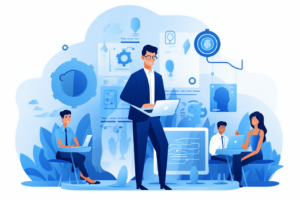Unlocking opportunities: empowering employees through internal talent sourcing and career frameworks
- 5 Min Read
In the rapidly changing world of work, forward-thinking firms are increasingly embracing the value of internal talent sourcing and career frameworks
- Author: Finbarr Toesland
- Date published: Sep 20, 2023
- Categories

The modern workplace found in businesses today contains a diverse range of employees, each with their own valuable talents. As staffing needs evolve in response to changing business needs, organizations are increasingly turning to their internal talent pools to find the right skillsets required to meet complex operational needs, reducing over-reliance on more expensive and scarce external talent.
Tapping into the current workforce through internal talent sourcing can bring both employees and employers a host of benefits, as efficiencies are unlocked, and a robust organizational structure is built. Establishing career frameworks can also help create a symbiotic relationship between organizational success and individual growth, linking employee development and company prosperity.
Benefits of internal talent sourcing
Internal candidates benefit greatly from already knowing corporate culture and operations, resulting in a strong cultural fit and reducing potential workplace friction. It’s no surprise this deep understanding of institutional knowledge and the organization’s values gives internal candidates a head-start over external candidates, who may be more difficult to assess for a culture fit.
Recruitment timelines and onboarding can be reduced when hiring internally as they typically need less time to adjust to the new position and are ready to hit the ground running. The combination of these factors means that internal hiring is more cost-effective than external recruitment. A company will not need to spend large amounts of time filtering out external candidates, getting to know new job seekers, and working out if they would be a good fit.
The evolution of career frameworks
There is no question that conventional career paths have evolved in recent years to a modern concept of career frameworks. One of the key reasons for this development is the difficulty found when trying to align traditional hierarchical structures with the flexibility that is increasingly needed for modern career development.
“Effective frameworks provide visibility to the way in which work is done within the organization, the requirements in order to do that work well, and provide access for individuals to the learning resources,” explains Mark McGowan, UK Workforce Reward Lead at consulting firm Mercer.
Designing effective organizational structures
Traditional organizational structures are unlikely to give businesses the ability to quickly adjust and may hamper, rather than enable, the facilitation of talent mobility and cross-functional collaboration.
Adaptable organizational structures are an important element for any business seeking to empower employees through internal talent sourcing and career frameworks. By embracing a mix of fluid job roles and project-based teams, that offer lateral movement, skill development can be encouraged, and employee engagement boosted.
Building transparent career progression models
Clear pathways for employee development should be created to ensure that both the organization and staff can establish plans and strategies for the future. In all businesses, especially those operating in rapidly changing industries, it is essential to build skills and capabilities in a way that matches how required work will change as the business is forecast to grow.
In practice, these transparent pathways are best placed to succeed when they are supported by workforce planning, competency frameworks, skill assessments, and performance metrics. “From a strategic point of view, these models help create a future ready platform that makes sure organizations have the capabilities within the business to support future needs,” adds McGowan.
Empowering employee development
Career frameworks have the potential to have a major positive impact on employee empowerment and engagement, when used in partnership with mentorship programs and personalised development plans.
Some organizations with large numbers of employees may face challenges in providing personalized development opportunities at scale. However, by focusing on transparency and ensuring each employee has visibility to opportunities that are relevant to them based on their capabilities, a clear contribution to individual growth and job satisfaction can be achieved.
“From a fairness point of view, transparency and access to development opportunities and career opportunities helps to break down a lot of barriers and empower employees,” says McGowan.
Aligning employee and organizational objectives
Showing what future opportunities are available to employees, based on where their capabilities could fit in different parts of the company, not only offers staff more visibility on their career path, but also helps align their aspirations with organizational goals.
When employees feel they have a place in the organization and an exciting future path to follow, it can lead to a more motivated and dedicated workforce. Deepening the relationship between employee development and organizational success fosters a resilient workforce and unlocks opportunities for innovation.
Implementation of best practices
While each organization will have its own unique approach to internal talent sourcing and career frameworks, there are key steps that would benefit all businesses to consider. An integrated effort should be made across the business, which is owned across the organization, as well as being sponsored and maintained on an ongoing basis.
A broad range of stakeholders are essential for implementation to be successful, with it being vital for leadership from all departments to be involved in the establishment of internal talent-sourcing initiatives to ensure strong alignment is achieved between employee development and the future work required to match changing business needs.
“Ensuring that use cases and organizational benefits at the organization are discussed and clarified upfront will help everyone to see how this structure can be applicable to their needs from a business perspective. This gets buy in and ownership to make this sustainable as a structure,’ explains McGowan.








